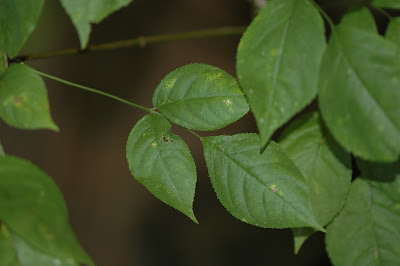It's nice every now and then to return to the stomping grounds you explored as a kid. Looking for critters in Mill Hollow and French Creek played a big part in my becoming interested in this field. This time I visited Black River Reservation between Elyria and Sheffield Lake.
I'll start with the exotic species I mentioned. This is Sitochroa palealis, a Crambidae Pyralid moth.
Two years ago a paper was published on this species. Probably introduced to the Great Lakes states through shipping ports, it was known from Illinois, Indiana, Michigan, and Wisconsin. I am told it is now widespread in Ohio as well. It feeds on Queen Anne's Lace, or Wild Carrot, another exotic. Should it remain there, it will probably be paid no mind, but if it ends up in agricultural crops, be sure, you'll hear about it again.
Green pretzel sticks. Actually they're called catkins. This is one of the things common in the Birch family. These are from Smooth Alder, Alnus serrulata. Musclewood, Hop-hornbeam, and Hazelnut are also in the birch family. These greenies will turn purple come winter.
What's different about the birch family members is the seed casing they produce. In alders they look like little pine cones.
A group of plants often overlooked are the Bedstraws. Their small white flowers, some think all look alike, are separated by the leaves and stem. This is Shining Bedstraw, Galium concinnum. The stems are weak, so they tend to hang against other plants. The stems are smooth, and the leaves are in whorls of 4-6, usually 6. It's found in almost every county of Ohio.
Bedstraws really aren't that difficult to figure out, but this group is something else. I never shy away from a taxonomic challenge, but the Knapweeds present a problem. There may be 8-10 species in Ohio, ALL of them introduced exotics.
Knapweeds all have similar looking flowers, and many with similar leaves. Like some of the thistles, you have to look at the phyllaries on the flower head.
This one looks like it has little brown 'ticks' sitting at the end of the upper filaments, and unhusked 'corn on the cob' on the lower portions. From this I believe it is Short-fringed Knapweed, Centaurea nigrescens (dubia). A similar species, Spotted Knapweed C. biebersteinii (maculosa), has highly divided leaves, and this plant didn't. All the knapweeds are widely distributed around the state in open fields.
This is Wild Mint, Mentha arvensis. Mints have square stems and very aromatic leaves. Like most plants, many of the mints have flowers at the top of the plant, but Wild Mint, Water Horehounds, Bugleweeds, etc., have clusters of flowers growing in the axils throughout the stem.
Leaves of three, leave it... wait a minute. These leaves are rounder and have a fine row of serrations on the margin. Not Poison Ivy but Bladdernut, Staphylea trifolia. This is a native shrub.
Besides the three leaves, the speckled twigs aid in identification.
The fruit of Bladdernut is a 3-sided bladder-like pod. It's hollow, green at first, turning brown in fall and winter. The seeds break loose, and when you shake the pods they sound like a rattlesnake. Eventually the pod breaks down and the seeds drop through holes in the bottom.
The flowers of Bladdernut look like clusters of little bells. Look for them in the spring.
Common in bottomlands of northern Ohio is the Bur Oak, Quercus macrocarpa. The scales on the cap are long and pointed, giving it the other common name, Mossy-cup Oak.
While I've posted Clematis fruit before, I wanted to put this one up to show why it's sometimes called Old Mans Beard.
Walking along the river is a good place to find Dolomedes spiders. Called Nursery Web Spiders or Fishing Spiders, they usually are found under bark, on logs, or anyplace near water. This one was not as big nor as dark as some I've seen. I'm still learning my spiders, but this looks like Dolomedes tenebrosus. Many people mistakenly call these wolf spiders.
On the plant next door was this daddy-longlegs. I'm thinking this is Leiobunum vittatum, the Striped Harvestman. They are much lighter early in the summer, turning this dark color come fall.
This side view allows one to see that like insects, all legs are attached to the upper body region, never the abdomen. In Arachnids and Crustaceans, the head and thorax are fused into a Cephalothorax.
At first I thought it was pretty neat to walk right up to this deer, but then I remembered I'm in a park, they're used to people. Folks in the know from Cleveland to Cincinnati are aware that deer + metro park = royal pain. Dear me




















No comments:
Post a Comment